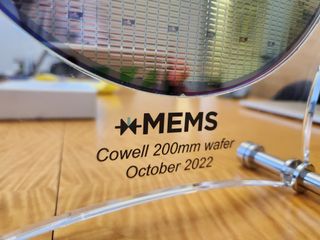The future of audio? World’s first solid-state speakers may transform earbuds
Smaller + cheaper = better

Solid state drives transformed computer storage, offering greater capacity that proved cheaper and more reliable. And much smaller! You might not have heard about it, but solid-state tech also handily changed the market for condenser mics, offering smaller devices that are easier to incorporate with other circuits. They’re just better – and cheaper.
Today, a company called xMEMS Labs is introducing the world’s first solid-state speakers, teeny weeny little devices meant to replace the coils and magnets that have powered speakers since the technology was invented over a hundred years ago.
You can be forgiven for not recognizing the name MEMS. Micro-electrical mechanical systems used piezo tech (simply put, it converts electrical impulses into mechanical movement) to reshape inkjet printing years ago, offering a way to finely control the spray of micro drops from a printer head.
They’re micro-spraying sound into your ears
Now they’re micro-spraying sound into your ears. The Cowell is the world’s smallest solid-state micro speaker, xMEMS Labs says, the Montara Plus offers the world’s highest output, and the Skyline DynamicVent offers vents to enable advanced adaptive noise canceling that literally shuts out the world.
But are they better than those AirPods Pro 2? To see just how good these devices are, I joined VP of marketing and biz dev Mike Housholder for an early demo of the technology using prototype devices. The prototypes look like rough versions of any earbud you might use, but they sound absolutely incredible.
Unless you use ultrahigh-end earbuds like fancy Sennheisers, you probably don’t think twice about the fact that sound from your existing buds is kind of crummy. And don’t take our word for it: Go pop your current buds in your ears for a second and actually think about what you’re listening to. It isn’t great.

By employing that thin film piezo technology as the speaker actuator instead of a coil and magnet, and using silicon instead of a paper or plastic speaker cone, xMEMS has built a better sound trap. The speakers are 40% smaller than ordinary drivers, 90% lighter, and with no moving parts, they’re far more durable.
Get daily insight, inspiration and deals in your inbox
Get the hottest deals available in your inbox plus news, reviews, opinion, analysis and more from the TechRadar team.
“Solid state fidelity is a game changer,” Housholder said.
The new speakers support high-res audio and boast audiophile specs, but more than anything else, they capture the depth and range of music that I miss in most streaming audio. I listened to Kacey Musgraves' “Slow Burn” and caught nuance in the guitar work I’d missed in other listens, for example.
You won’t be able to buy speakers based on this technology anytime soon, but xMEMS says it is shipping the components now. Expect to see products using them on the market this holiday season for under $200, a killer entry point for pro-level audio.

After 25 years covering the technology industry, Jeremy Kaplan is a familiar face in the media world. As Content Director for TechRadar, he oversees product development and quality. He was formerly Editor in Chief of Digital Trends, where he transformed a niche publisher into one of the fastest growing properties in digital media. Before that, he spent half a decade at one of the largest news agencies in the world, and cut his teeth in magazine business, long before the birth of the iPhone. In 2019, he was named to the FOLIO: 100, which honors publishing professionals making an industry-wide impact.
Most Popular



